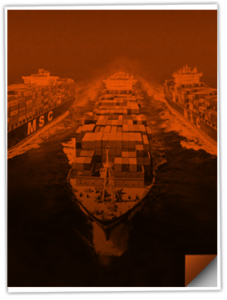Featured Headlines:
Oh Savannah, Won’t You Supply for Me?
Asia-Europe: Carriers Have Audacity to Lower Capacity
US Schools World Trade with A Lesson in Reciprocal Tariffs
Rising Duties Call for Higher Bonds…Are You Prepared?
Maximus EU Alignment on De Minimis
Supply Chain Shuffle: China's Decoupling
Freight Market Shift: Real Recovery or Another False Start?
North American Rail Service Satisfaction Not Guaranteed
Transpacific Plans Specific
- While we shippers have grown accustomed to Lunar New Year blanks and chants of “Roll Pools!” from ocean carriers sounding like Crimson Tide fans, this year’s season was extra special and magical!
- Lousy weather at origin coupled with the launch of the Twins of Gemini and the premier of The Premier (thankfully replacing the THE) frequently thwarted clever shipper plans to beat the tariffs to first base sail dates in a photo finish.
- But these clever words must be hyperbole to a large extent, scholars. Why?
- Because ocean rates have been a’ tumblin’ tumblin’ and a’ crumblin’ crumblin’ since Lunar New Year!
- For the West rates dropped immediately and took two weeks to slim by 20%; not to be outdone, the East, though shy for a week, dropped the weight by 20% in a single week.
- The plans for Ocean Alliance, Premier, Gemini, and MSC are plain to see. The name of the game is market share, pure and simple!
- As rates wither on the vine, it seems clear that shipper demand has been frontloaded so many times that we may well be in our first soft import market since early 2024. That said tariff panic is alive and well, so maybe the “engine that could” will (yet again).
- Also, despite the blood thirst for market share, here comes contract season. What a horrendous time for FAK rates to slide to the bottom of the seas. You KNOW the carriers will blank the blank out of the market and float some tenuous GRI’s our way.
- As usual, who needs Broadway this time of year? The show is on in the Transpac!
Oh Savannah, Won’t You Supply for Me?
- The Port of Savannah, home to the Western Hemisphere’s largest container terminal, Garden City, has had a malingering case of vessel congestion since Enzo took them by storm (quite literally) a month ago on January 21st.
- Before we hearty Midwesterners, tough Northerners, and absurdly sophisticated well-mannered Mid-Atlanticians scoff, Savannah did ALMOST get four inches of snow, yo!
- Hey, it was nearly one inch of snow per day the port was closed for business!!
- As we tease and gently mock our Southern cousins, it is compelling to note that the last snow event in the area was in 2018. Did we REALLY think that local governments or Georgia Ports would budget for salt, plows, and…. knit caps?
- Since the storm, we have seen as many 25 vessels waiting to berth, and shippers (and natives) have grown restless waiting to get their greedy mitts on (or off) their cargo.
- Today, there are still 10 commercial vessels waiting for their turn with another 10 scheduled to arrive in the next three days. This is the worst case of congestion for this prestigious port since COVID.
- Unfortunately, Savannah’s large-scale traffic jam has not only been worsened by vessel bunching, but the port has grown impressively over time, attracting business easily based on their access to land for growth and their highly efficient cargo handling. Hmmmmm!
- Come on, Georgia Ports, show us what you’re made of, would ya?!
Asia-Europe: Carriers Have Audacity to Lower Capacity
- What do we read about European container lines? Well, MSC is taking over the world, of course… and the Gemini twins, Maersk and Hapag, are reinventing modern containership realities with the primitive concept of a hub and a spoke! Yet, what do we learn in 2025?
- The Asia-North Europe trade is bracing for an 11% drop in liner capacity as the new shipping alliances settle into place, that’s what!
- Here are some musty details:
- Weekly sailings are climbing from 26 to 28, but overall capacity is shrinking from 249,000 TEU to 221,000 TEU per week.
- The Ocean Alliance is holding steady with six weekly services, offering 94,000 TEU of capacity per week.
- The Premier Alliance, working with MSC, will run five services, providing 59,000 TEU weekly.
- The Gemini Cooperation will operate four services, offering a combined weekly capacity of 40,000 TEU.
- Weekly sailings are climbing from 26 to 28, but overall capacity is shrinking from 249,000 TEU to 221,000 TEU per week.
- When we expand our view to include the Asia-Mediterranean trade, it’s a different story—there is no change in weekly sailings, but overall capacity edges up by nearly 5%.
US Schools World Trade with A Lesson in Reciprocal Tariffs
- On February 13, 2025, a presidential memorandum was signed to initiate a comprehensive investigation process for implementing reciprocal tariffs in the United States.
- According to a source from inside the White House, the Trump Administration will not immediately impose additional tariffs; the goal is to allow other countries the opportunity to either lower and/or eliminate their existing tariffs on US goods first.
- Countries with the highest tariffs on US goods will be first on the review docket.
- Within 180 days of the date of this memorandum, the Director of the Office of Management and Budget shall assess all fiscal impacts on the Federal Government and the impacts of any information collection requests on the public and shall deliver an assessment in writing to the President.
- For more details, please refer to the Federal Register Notice published on February 19, 2025.
Rising Duties Call for Higher Bonds…Are You Prepared?
- With the threat of further tariffs just around the corner, Shapiro is encouraging importers to take a close look at their Customs bonds and evaluate their level of bond saturation.
- Why are we suggesting this? Because now is as good of a time as any to take stock of current processes, make adjustments and proactively prepare to avoid a future fraught with bond insufficiencies and stacking exposure.
- Currently, US Customs and Border Protection (CBP) requires importers to post a bond representing 10% of their duties, taxes, and fees for a rolling 12-month window.
- Calculating this magic number can be burdensome and difficult given the tariff landscape’s future uncertainties—but it’s the first step to being prepared.
- As of now, it seems likely that importers will face higher Customs bond scrutiny in this new environment. So, do not be surprised if you are faced with the following increases:
- Bond costs
- Collateral requirements to manage risks
- Importer ACH Debit/Credit
- Approved Periodic Monthly Statements (PMS)
- Don’t let heightened duty rates get a rise out of you. Reach out to Shapiro’s Regulatory Compliance Experts if you need help evaluating your customs bond today!
Maximus EU Alignment on De Minimis
- While free speech is still in play (ha ha!), let’s just say publicly that relations between Europe and the US are not what our parents would have called “peachy keen.” From a certain war to “enemies within” to the definition of fair trade, we may be reaching tensions with Europe not seen since WWII. Oh goodie!
- Yet, there is a beacon of hope, worried Americans and Europeans!
- The European Commission (EC) has aligned with the US in calling for the removal of the de minimis exemption for low-value parcels, a key driver of surging Chinese e-commerce imports via air cargo.
- The EC’s new proposal—dubbed “A Comprehensive EU Toolbox for Safe and Sustainable E-commerce”—aims to curb the influx of unsafe, counterfeit, and non-compliant goods, including a coordinated action against Shein.
- In 2024, 4.6 billion duty-free parcels under the €150 threshold entered the EU, double the previous year’s volume. In the U.S., two-thirds of the 1.36 billion de minimis imports came from China.
- Removing de minimis could create operational bottlenecks as millions of parcels face Customs checks…. just ask the USPS what THEY think!
- Chinese platforms like Temu and Shein are already adjusting, increasing ocean freight use, building inventories in strategic (often undisclosed) locations in Europe, the US, and Mexico.
- While de minimis removal threatens short-term disruption, the long-term play seems clear: e-commerce giants are adapting fast, shifting supply chains to stay in the game.
Supply Chain Shuffle: China's Decoupling
- The logistics world is reshuffling, and China’s grip on global manufacturing is loosening. The Emerging Markets Logistics Index by Agility and Transport Intelligence (Ti) shows companies are rethinking their sourcing strategies.
- 54% of logistics pros plan to move production or sourcing out of China by 2030, a 16.6% jump from last year’s survey.
- Top reasons include the China-U.S. trade war (14.2%), rising labor costs (11.7%), tighter domestic regulations (11.3%), and the push for supply chain diversification (10.7%).
- North America is up 12.9%, thanks to strong infrastructure, proximity to markets, and reshoring incentives. Sub-Saharan Africa gained 9.9%, boosted by low costs, abundant resources, and an ecommerce boom. Southeast Asia saw a 4.9% increase as companies seek cost-effective alternatives near existing supply routes.
- India experienced a 31% net outflow, with businesses citing rising costs, red tape, and corruption (18.3%). The MENA region saw a 4.7% decline due to geopolitical risks and competition.
- Despite the exodus, China’s expertise, scale, and infrastructure mean companies must keep a foothold in China for efficiency while expanding into other regions for resilience.
Freight Market Shift: Real Recovery or Another False Start?
- US intermodal and truckload carriers are eyeing signs that the freight recession could finally be winding down, with shippers making a last push for lower contract rates before the market swings in carriers’ favor. Still skepticism remains high after multiple false starts.
- Werner Enterprises CEO Derek Leathers pointed to rising tender rejection rates as a sign that capacity and demand are balancing, though some shippers report flat 2025 contract rates with no noticeable rejection uptick.
- Historically, intermodal rates follow trucking trends. Several IMCs expressed disappointment with 2025 bids, often losing last-minute to J.B. Hunt and Hub Group’s aggressive pricing.
- Hub Group prioritizes customer retention to secure future rate hikes, while Schneider National focuses on pricing discipline, slowing volume growth but achieving the only year-over-year revenue increase among top intermodal providers.
- While the market seems to be shifting, the recovery is likely to be a slow grind rather than a sharp turnaround. Carriers may finally see some pricing power return, but 2025 contract rates still reflect shipper leverage—at least for now.
North American Rail Service Satisfaction Not Guaranteed
- Satisfaction with North American freight railroads dipped in late 2024 as rail networks buckled under heavy peak-season import volumes, according to the latest Journal of Commerce Intermodal Service Scorecard (ISS).
- Only 77.5% of intermodal providers were satisfied with Class I rail performance, down from 91.2% earlier in the year.
- Despite rail struggles, 91% of shippers remained satisfied with their carriers and brokers, slightly up from 90.1% in the first half.
- CSX was rated the top-performing intermodal railroad while BNSF earned the highest overall score across key performance metrics.
- While delays occurred, IMCs noted that railroads handled peak-season volumes far better than during the pandemic, with bottlenecks largely cleared by late November.



